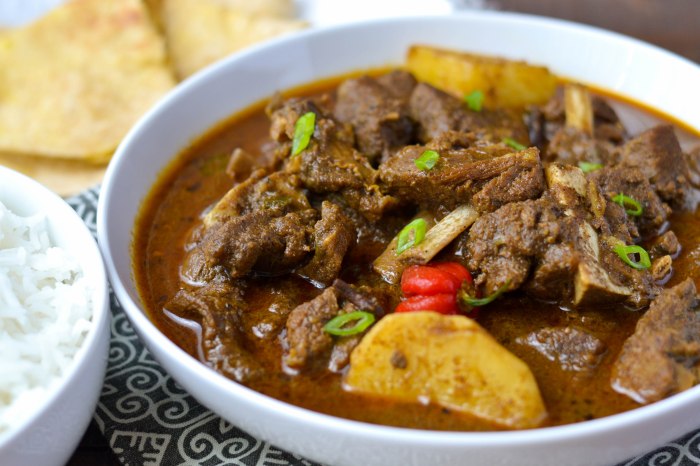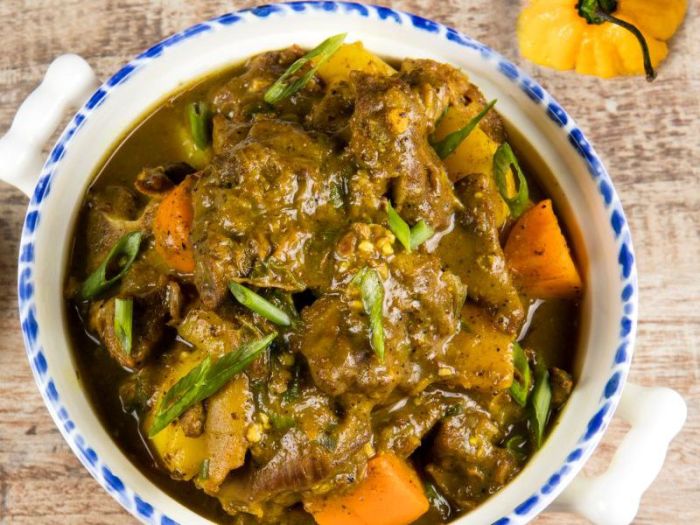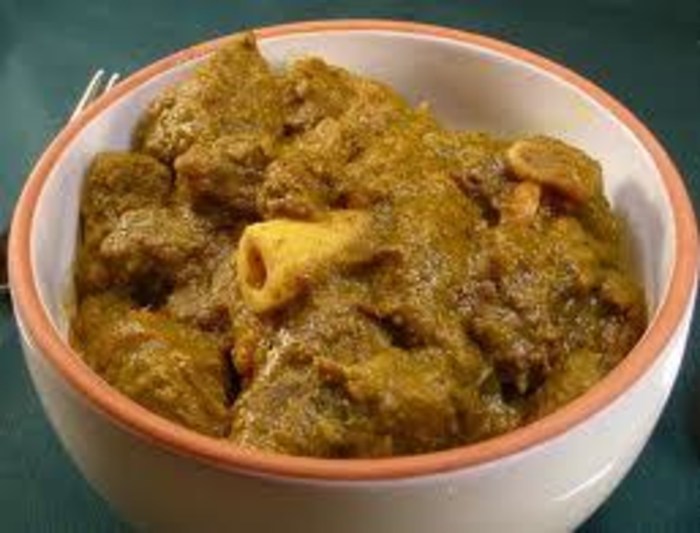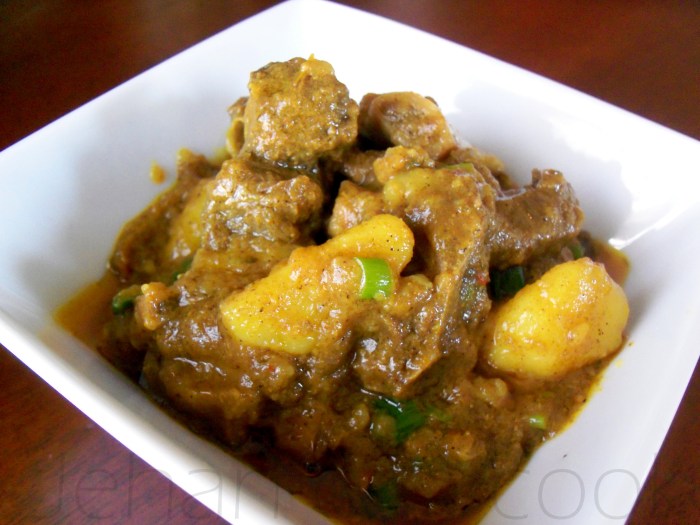Curry goat recipe, a culinary masterpiece born from the rich traditions of the Caribbean and South Asia, invites you on a flavorful journey. This dish, a testament to the fusion of cultures and spices, boasts a history as vibrant as its aroma.
From its humble beginnings to its global popularity, curry goat has captured hearts and palates worldwide, leaving an unforgettable mark on the culinary landscape.
The heart of this dish lies in the perfect blend of spices, each contributing its unique essence to create a symphony of flavors. From the warmth of ginger and garlic to the fiery heat of chilies, the aroma alone promises a tantalizing experience.
Introduction to Curry Goat
Curry goat is a beloved dish that has captured the hearts and palates of food enthusiasts worldwide. Its origins can be traced back to the Caribbean, where it was developed by enslaved Africans who used readily available ingredients to create a flavorful and satisfying meal.The cultural significance of curry goat is deeply rooted in the history and traditions of various regions.
In Jamaica, it is considered a national dish and is often served at special occasions and celebrations. In other Caribbean islands, such as Trinidad and Tobago, it is a staple food that is enjoyed by people of all backgrounds.
Key Ingredients of Curry Goat
The distinct flavor profile of curry goat is achieved through a unique blend of spices and herbs. The following are some of the key ingredients that define this iconic dish:
- Goat Meat:The star ingredient of curry goat, goat meat is known for its tender texture and rich flavor. It can be prepared using different cuts, such as shoulder, leg, or ribs, depending on personal preference.
- Curry Powder:A blend of spices that varies depending on the region and the chef’s recipe. Common ingredients in curry powder include turmeric, cumin, coriander, ginger, and chili peppers. The combination of spices creates a complex and aromatic flavor profile that is essential to curry goat.
- Onions:Onions are used to add sweetness and depth of flavor to the curry. They are often sautéed with the spices before the goat meat is added.
- Garlic:Garlic adds a pungent and savory note to the dish. It is usually minced or crushed and sautéed with the onions and spices.
- Scotch Bonnet Peppers:These peppers provide a fiery kick to the curry. The amount of Scotch bonnet peppers used can be adjusted to taste, ranging from a mild heat to a scorching hot experience.
- Tomatoes:Tomatoes add sweetness and acidity to the curry, balancing out the spiciness of the Scotch bonnet peppers. They are often chopped or crushed and added to the pot along with the other ingredients.
- Coconut Milk:Coconut milk adds a creamy texture and a hint of sweetness to the curry. It is typically added towards the end of the cooking process to prevent it from curdling.
- Other Herbs and Spices:Depending on the recipe, other herbs and spices may be added to enhance the flavor of the curry. These can include thyme, bay leaves, allspice, and black peppercorns.
Essential Ingredients
A delicious curry goat recipe hinges on the perfect blend of spices and ingredients that work harmoniously to create a rich, complex flavor profile. Let’s explore the essential ingredients that make this dish a culinary masterpiece.
Essential Ingredients
The following table details the essential ingredients for curry goat, their quantities, and their roles in enhancing the flavor profile:
| Ingredient | Quantity | Purpose |
|---|---|---|
| Goat Meat | 1.5
|
The star of the show, providing the main protein source and a distinctive, slightly gamey flavor. |
| Curry Powder | 2-3 tablespoons | A complex blend of spices that forms the foundation of the curry’s flavor. Common spices in curry powder include turmeric, cumin, coriander, ginger, and chili powder, each contributing to the dish’s warmth, depth, and aromatic qualities. |
| Onions | 2 medium | Add sweetness and a base for the curry sauce. They are typically diced and sautéed to release their natural sugars. |
| Garlic | 4-5 cloves | Adds a pungent and savory note, enhancing the overall depth of flavor. |
| Ginger | 1 tablespoon (grated) | Provides a warm, slightly spicy, and earthy flavor that complements the other spices. |
| Scotch Bonnet Peppers | 1-2 (or to taste) | Contribute a fiery heat and a distinct fruity aroma, adding complexity to the curry. |
| Tomatoes | 2 large (diced) | Add a touch of sweetness and acidity, balancing the spices and enriching the sauce’s texture. |
| Coconut Milk | 1 can (14 oz) | Provides a creamy, rich texture and a subtle sweetness that balances the spice. |
| Vegetable Oil | 2-3 tablespoons | Used for sautéing the onions and garlic, ensuring the flavors develop properly. |
| Salt and Pepper | To taste | Seasoning agents that enhance the flavors of the dish and adjust the overall taste profile. |
| Water | As needed | Used to adjust the consistency of the sauce and ensure the goat meat cooks thoroughly. |
Preparing the Goat Meat
The key to a delicious curry goat is using the right cut of meat and preparing it properly.
Let’s explore the best cuts for curry and how to bring out the best flavor in your goat meat.
Choosing the Right Cut of Goat Meat
When selecting goat meat for curry, consider the following cuts:
- Shoulder:This cut is well-marbled, offering a rich flavor and tender texture after slow cooking. It’s ideal for curries because it breaks down easily and absorbs the spices beautifully.
- Shank:This cut is known for its robust flavor and rich, gelatinous texture. It’s a great choice for slow-cooking methods, where it breaks down into tender, succulent pieces.
- Neck:This cut offers a balance of lean meat and fat, resulting in a flavorful and tender curry. It’s also a more affordable option compared to other cuts.
Marinating the Goat Meat
Marinating goat meat is crucial for enhancing its flavor and tenderness. Here’s a simple and effective marinade:
- Ingredients:
- 1 cup plain yogurt
- 1 tablespoon ginger-garlic paste
- 1 teaspoon turmeric powder
- 1 teaspoon cumin powder
- 1 teaspoon coriander powder
- 1 teaspoon garam masala
- 1/2 teaspoon red chili powder (adjust to taste)
- Salt to taste
- Instructions:
- Combine all marinade ingredients in a bowl and mix well.
- Add the goat meat to the marinade and ensure it’s fully coated.
- Cover the bowl and refrigerate for at least 2 hours or overnight for maximum flavor infusion.
Browning the Goat Meat
Browning the goat meat before adding other ingredients is essential for developing a rich, caramelized flavor.
You also will receive the benefits of visiting smoked cream cheese recipe today.
- Instructions:
- Heat a large pot or Dutch oven over medium-high heat.
- Add a tablespoon of oil to the pot.
- Carefully place the marinated goat meat into the hot pot, making sure not to overcrowd the pan.
- Sear the meat on all sides until it develops a nice brown crust. This will take about 5-7 minutes per side.
- Remove the browned goat meat from the pot and set it aside.
Curry Paste and Spice Blend
The heart and soul of a curry goat lies in its vibrant, aromatic curry paste and spice blend. This flavorful foundation provides the dish its signature depth and complexity, bringing together a symphony of warm, earthy, and slightly fiery notes.
Curry Paste Options
Curry paste is the cornerstone of the curry goat’s flavor profile. It’s a concentrated blend of spices, herbs, and aromatics that creates a rich, flavorful base.
- Store-bought curry paste:These pastes are readily available in supermarkets and specialty stores, offering a convenient option for those short on time. They come in various flavors, from mild to fiery, catering to different taste preferences. However, it’s important to check the ingredients list, as some pastes may contain additives or preservatives.
- Homemade curry paste:Making your own curry paste allows for greater control over the ingredients and flavor profile. This gives you the freedom to customize the blend to your liking, adjusting the spice levels and incorporating your favorite herbs and aromatics.
Creating a Homemade Curry Paste
Here’s a basic recipe for a homemade curry paste:
Ingredients:
- 1 tablespoon ground coriander
- 1 tablespoon ground cumin
- 1 tablespoon ground turmeric
- 1 tablespoon ground ginger
- 1 tablespoon ground cinnamon
- 1 teaspoon ground cloves
- 1 teaspoon ground black pepper
- 1 teaspoon cayenne pepper (adjust to your desired heat level)
- 1 teaspoon salt
- 1/2 teaspoon ground cardamom
- 1/4 cup water
- 2 tablespoons vegetable oil
Instructions:
- In a small bowl, combine all the dry spices.
- Heat the oil in a small saucepan over medium heat. Add the spice mixture and cook for 2-3 minutes, stirring constantly, until fragrant.
- Add the water and bring to a simmer. Reduce the heat to low and simmer for 5 minutes, stirring occasionally, until the paste thickens.
- Remove from heat and let cool slightly. Store in an airtight container in the refrigerator for up to 2 weeks.
Spice Blends in Curry Goat, Curry goat recipe
Different spice blends are commonly used in curry goat, each imparting its unique flavor profile.
- Jamaican curry powder:This blend typically includes ground allspice, cumin, coriander, turmeric, and black pepper. It’s known for its warm, earthy, and slightly sweet flavor, adding a distinctive Jamaican touch to the dish.
- Indian curry powder:This blend often incorporates a wider range of spices, including cardamom, cinnamon, cloves, and chili powder. It tends to be more complex and aromatic, with a balance of sweet, savory, and spicy notes.
- Thai curry paste:This paste typically features lemongrass, galangal, kaffir lime leaves, and chili peppers. It offers a unique blend of citrusy, floral, and spicy flavors, adding a refreshing twist to the curry goat.
Cooking the Curry Goat: Curry Goat Recipe

The magic of curry goat lies in its slow cooking process, which allows the flavors to meld and the meat to become incredibly tender. There are a few popular methods you can use to achieve this delicious result.
Stovetop Cooking
Cooking curry goat on the stovetop offers a more hands-on approach, allowing you to monitor the process and adjust the flavors as needed.
- Start by browning the goat meat in a large pot over medium heat. This helps to develop a rich flavor and creates a beautiful crust on the meat.
- Add the curry paste and spices, stirring until fragrant. This step infuses the meat with the delicious aromas of the curry blend.
- Pour in the coconut milk and broth, ensuring the meat is fully submerged. The coconut milk adds a creamy texture and a hint of sweetness, while the broth provides the necessary liquid for simmering.
- Bring the mixture to a boil, then reduce the heat to low, cover the pot, and simmer for 2-3 hours, or until the goat meat is incredibly tender. The longer you simmer, the more flavorful the curry will become.
- As the curry simmers, check the consistency and adjust the liquid as needed. If the curry becomes too thick, add a little more broth or water. If it’s too thin, simmer it uncovered for a few minutes to reduce the liquid.
- Once the goat meat is tender and the curry has reached the desired consistency, remove it from the heat and serve hot with rice, roti, or your favorite accompaniments.
Serving and Accompaniments

Curry goat is a versatile dish that can be enjoyed in various ways. It’s traditionally served with rice, roti, or other flatbreads, and accompanied by flavorful sides that complement its richness and spice.
Traditional Accompaniments
Traditional accompaniments enhance the curry goat experience by providing contrasting textures and flavors.
| Accompaniment | Description | Serving Suggestions |
|---|---|---|
| Rice | A staple accompaniment, often served plain or with a sprinkle of chopped cilantro. | Serve alongside the curry goat, allowing the rice to absorb the flavorful gravy. |
| Roti | A flatbread made with flour, water, and sometimes ghee or oil. | Use roti to scoop up the curry goat and its sauce, offering a soft and slightly chewy texture. |
| Dhal | A lentil stew with spices, often served with a hint of heat. | The creamy texture and mild heat of dhal provide a balance to the richness of the curry goat. |
| Chopped Onions | Raw or lightly pickled onions offer a refreshing crunch and tangy flavor. | Sprinkle chopped onions over the curry goat for a contrasting flavor and texture. |
| Pickled Mango | Sweet and sour pickled mango adds a burst of flavor and acidity. | Serve pickled mango alongside the curry goat for a refreshing and tangy counterpoint. |
Garnishes
Garnishes add a finishing touch to curry goat, enhancing its aroma and visual appeal.
Common garnishes include chopped cilantro, fresh green chilies, lime wedges, and a sprinkle of curry powder.
Variations and Adaptations

Curry goat is a versatile dish that can be adapted to suit various tastes and preferences. From regional variations to dietary considerations, there are many ways to customize this flavorful Caribbean staple.
Regional Variations
Regional variations of curry goat often reflect the unique culinary traditions and ingredients available in different parts of the Caribbean. For instance, Jamaican curry goat typically features a vibrant orange hue due to the use of Scotch bonnet peppers, while Trinidadian curry goat might incorporate a blend of spices like cumin, coriander, and turmeric, resulting in a more earthy flavor profile.
- Jamaican Curry Goat: Known for its fiery heat and vibrant orange color, Jamaican curry goat often uses Scotch bonnet peppers, allspice, and thyme for a distinctive flavor.
- Trinidadian Curry Goat: Trinidadian curry goat typically incorporates a blend of spices like cumin, coriander, and turmeric, resulting in a more earthy and aromatic flavor.
- Indian Curry Goat: In India, curry goat is often prepared with a variety of spices, including garam masala, ginger, garlic, and chili peppers, creating a complex and flavorful dish.
Dietary Adaptations
Curry goat can be adapted to suit various dietary needs and preferences. For example, individuals following a vegetarian or vegan diet can substitute the goat meat with jackfruit, tofu, or chickpeas. Additionally, those seeking a milder flavor profile can reduce the amount of chili peppers used in the recipe.
- Vegetarian/Vegan Curry: Substitute goat meat with jackfruit, tofu, or chickpeas for a meat-free version.
- Milder Flavor: Reduce the amount of chili peppers or use milder varieties like bell peppers for a less spicy curry.
- Gluten-Free: Ensure that all ingredients, including soy sauce, are gluten-free.
Alternative Ingredients
While the traditional curry goat recipe relies on specific ingredients, there are numerous alternatives that can be used to customize the flavor profile. For example, using different types of chili peppers, like habanero or scotch bonnet, can add a unique heat and flavor.
Similarly, experimenting with different herbs and spices, such as cilantro, parsley, or bay leaves, can enhance the overall aroma and taste of the dish.
- Chili Peppers: Experiment with different types of chili peppers, such as habanero or scotch bonnet, to adjust the heat level.
- Herbs and Spices: Add additional herbs and spices, such as cilantro, parsley, or bay leaves, to enhance the flavor.
- Coconut Milk: Substitute coconut milk for a richer and creamier texture.
Final Summary

Curry goat recipe is a culinary adventure that promises to tantalize your taste buds and transport you to a world of vibrant flavors. With its rich history, diverse ingredients, and endless possibilities for customization, this dish is a true testament to the power of food to connect cultures and create lasting memories.
Whether you’re a seasoned cook or a culinary novice, embark on this flavorful journey and discover the magic of curry goat.
